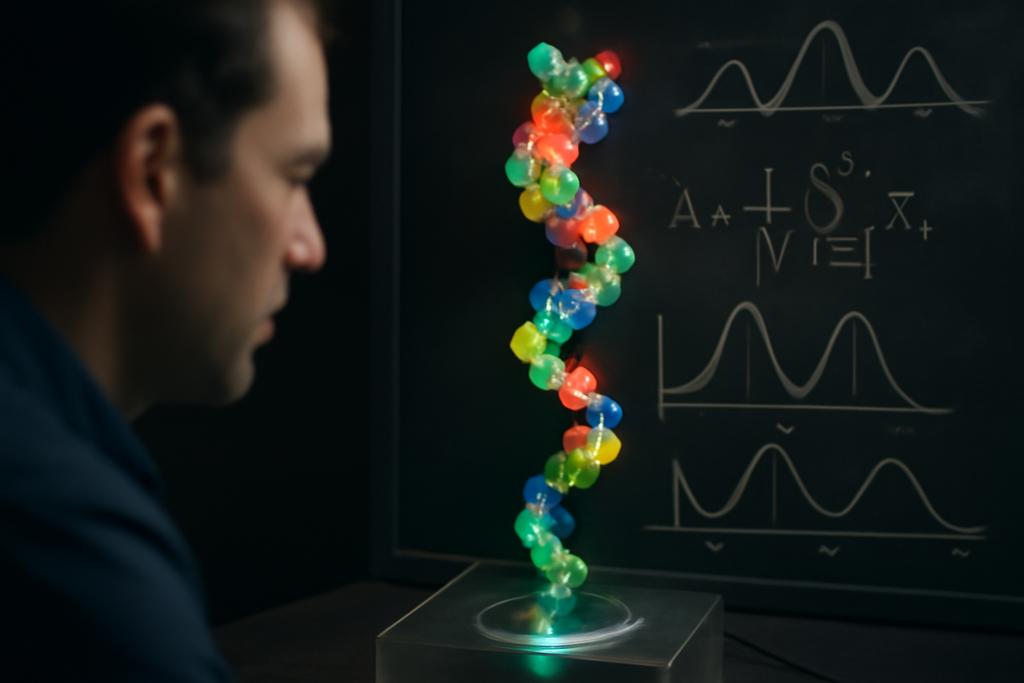Why Protein Sequencing Feels Like a Puzzle Missing Pieces
Proteins are the molecular machines of life, but unlike DNA, reading their sequences is a bit like trying to solve a jigsaw puzzle with many pieces hidden or erased. While DNA sequencing has leapt forward with technologies that read single molecules, protein sequencing still struggles with bulk measurements that blur individual details. This gap leaves scientists yearning for sharper tools to identify proteins one molecule at a time.
Enter a clever idea: what if we could tag certain amino acids in a protein with fluorescent colors and then watch the protein thread through a nanopore, a tiny hole that lets molecules pass one by one? As the protein moves, a laser excites these fluorescent tags, producing a colorful trace—a kind of barcode—that hints at the protein’s identity. This method, pioneered by researchers like Amit Meller and colleagues, promises about 96% accuracy in recognizing human proteins, a remarkable feat given the complexity involved.
From Colored Traces to Mathematical Channels
Jessica Bariffi, Antonia Wachter-Zeh from the Technical University of Munich, and Eitan Yaakobi from the Technion in Israel took this biological concept and translated it into the language of information theory—a branch of mathematics that studies how information is transmitted and reconstructed.
They imagined the protein sequence as a string of symbols drawn from an alphabet representing amino acids. The fluorescent tags correspond to selecting certain subsets of this alphabet—called “colorings.” When the protein passes through the nanopore, only the amino acids with these tags show up in the fluorescent trace, while the rest vanish from sight. Mathematically, this is like sending a sequence through a “coloring channel” that deletes all symbols not in the chosen subset.
But here’s the twist: instead of just one coloring, imagine multiple colorings applied simultaneously, each revealing a different subsequence of the original protein. The output is a tuple of colored subsequences, each missing different parts of the original sequence. The challenge? Can we reconstruct the original protein sequence perfectly from these partial glimpses?
Covering Designs: The Secret Sauce for Perfect Reconstruction
The researchers discovered that the key to flawless reconstruction lies in a beautiful combinatorial structure known as a covering design. In simple terms, a covering design is a collection of subsets (colorings) of the amino acid alphabet such that every pair of amino acids appears together in at least one subset. This ensures that no pair of symbols is ever completely hidden across all colorings.
Why pairs? Because if two amino acids never appear together in any coloring, swapping their positions in the sequence could produce identical colored subsequences, making it impossible to tell the sequences apart. Covering every pair guarantees that the colored traces collectively hold enough clues to uniquely identify the original sequence.
Balancing the Number and Size of Colorings
One might wonder: how many colorings do we need, and how big should each coloring be? The team tackled this by calculating the information rate and capacity of these coloring channels—measures of how much information about the original sequence survives the deletion process.
They found that the maximum information rate is achieved exactly when the colorings form a (q, c, 2)-covering design, where q is the alphabet size (number of amino acids), and c is the size of each coloring subset. This result elegantly ties the biological problem of protein identification to a classical problem in design theory.
Moreover, they identified the minimal number of colorings needed to guarantee perfect reconstruction, known as the minimal covering number. For example, when each coloring misses only one amino acid (c = q – 1), just three such colorings suffice to cover all pairs and reconstruct any sequence.
Why This Matters Beyond Proteins
This work is more than a theoretical exercise. It provides a rigorous framework to optimize experimental designs in single-molecule protein sensing. By knowing exactly how to choose which amino acids to tag and how many different tags to use, scientists can design more efficient nanopore experiments that maximize the chance of correctly identifying proteins.
Beyond biology, the concept of coloring channels and sequence reconstruction touches on fundamental questions in data transmission and error correction. It’s a fresh lens on how partial, noisy glimpses of information can be pieced together to reveal the whole story.
The Road Ahead: From Theory to Practice
While the math is elegant, real-world protein sequencing is messy. Fluorescence signals can be noisy, and proteins may fold or interact in unpredictable ways. Yet, this research lays a solid foundation for future algorithms that can handle such imperfections, guiding experimentalists on how to label proteins and interpret their colorful traces.
Jessica Bariffi, Antonia Wachter-Zeh, and Eitan Yaakobi’s study, funded by the European Union and conducted at the Technical University of Munich and the Technion, opens a new chapter in the quest to read life’s molecular code with precision and insight. It’s a reminder that sometimes, the colors we see are just the surface of a deeper mathematical harmony waiting to be uncovered.










